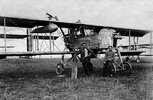British Ordnance Collectors Network
You are using an out of date browser. It may not display this or other websites correctly.
You should upgrade or use an alternative browser.
You should upgrade or use an alternative browser.
Identification of French WWI bomb
- Thread starter Big Sky Modeler
- Start date
No - probably a 50kg GA - the different coloration of the front part of he bomb body seems to indicate a 2 parts construction which is incompatible with the simiolar sized (and more frequent by 1917) 50kg DT bomb but characteristic of the GA (Gros Andreau) anilite bombs (overall height 1200mm)
Here is a photograph of a 50kg GAMMN - a former 200mm 50kg GA bdy filled with MMN:

By 1917 most GA body bombs were indeed filled with MMN but and rear fuzed.
The picture seems to show a bomb with a GA activation key
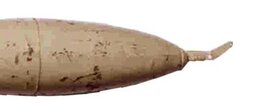
So 50kg Gros Andreau ?
Colors - good question without a straight answer. While Yellow was already the color for high explosive French projectiles, most of ww1 bombs seems to have been left natural metal, with various levels of corrosion due to exposure to weather. On the other hand we know that form 1918 to the early 1930s some French bombs (if not all ) were painted in gray-green in accordance to a 1918 regulation.
Here is a photograph of a 50kg GAMMN - a former 200mm 50kg GA bdy filled with MMN:

By 1917 most GA body bombs were indeed filled with MMN but and rear fuzed.
The picture seems to show a bomb with a GA activation key

So 50kg Gros Andreau ?
Colors - good question without a straight answer. While Yellow was already the color for high explosive French projectiles, most of ww1 bombs seems to have been left natural metal, with various levels of corrosion due to exposure to weather. On the other hand we know that form 1918 to the early 1930s some French bombs (if not all ) were painted in gray-green in accordance to a 1918 regulation.
But not a Voisin XIII which, like the Voisin XII, was a twin engined tractor bomber, much larger than the aircraft shown. This would appear to be a Voisin X, a pusher type. And quite a primitive design compared with the designs of other aircraft of the same period, designed in 1917 I believe.
Group de Bombardment 51 (GB 51)
----------------
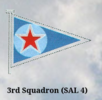
https://www.passionair1940.fr/Armee de l'Air/Escadrilles/Esc-Bomb-Assaut/GBA-2-51/EN-GBA_2-51.htm
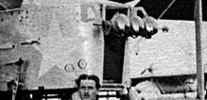
I see a similarity, what about you?
Akon
----------------

https://www.passionair1940.fr/Armee de l'Air/Escadrilles/Esc-Bomb-Assaut/GBA-2-51/EN-GBA_2-51.htm

I see a similarity, what about you?
Akon
Last edited:
The aircraft is a Voisin VIII - a standard WW1 French bomber, also used by the US,.
The nose radiator is the most notable apparent difference with the Voisin X which was almost identical but with a better engine.

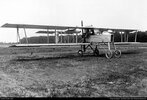
The voisin XII was a four engined prototype (the French system of coupling 2 engines in the same cowling - one with a propulsive propeller and the other one with a tractive propellel - a device much used on French "heavies" in the interwar period and early ww2 by Farman and Latecoere )
The voisin XIII was a never built planned develoipment of the Voisin XII.
Akon, the star painted on the fuselage of the aircraft is the insigna of the "escadrille 101" or VB 101
see: http://albindenis.free.fr/Site_escadrille/escadrille101.htm
The emblems of French interwar Groupes de Bombardement are different from the ones of the original ww1 escadrilles, though often with some relation to them., but almost always with some degree of modification
The picture uploaded in the first post appears in this same webpage with the following legend:
"Voisin VIII (type LBP) de l'escadrille VB 101 sur le terrain de Villeneuve-les-Vertus (Marne) en juin 1917 - Remarquez sous le fuselage le lance-bombes où sont accrochées verticalement les bombes - Le mécanicien au premier plan en présente une "
The nose radiator is the most notable apparent difference with the Voisin X which was almost identical but with a better engine.


The voisin XII was a four engined prototype (the French system of coupling 2 engines in the same cowling - one with a propulsive propeller and the other one with a tractive propellel - a device much used on French "heavies" in the interwar period and early ww2 by Farman and Latecoere )
The voisin XIII was a never built planned develoipment of the Voisin XII.
Akon, the star painted on the fuselage of the aircraft is the insigna of the "escadrille 101" or VB 101
see: http://albindenis.free.fr/Site_escadrille/escadrille101.htm
The emblems of French interwar Groupes de Bombardement are different from the ones of the original ww1 escadrilles, though often with some relation to them., but almost always with some degree of modification
The picture uploaded in the first post appears in this same webpage with the following legend:
"Voisin VIII (type LBP) de l'escadrille VB 101 sur le terrain de Villeneuve-les-Vertus (Marne) en juin 1917 - Remarquez sous le fuselage le lance-bombes où sont accrochées verticalement les bombes - Le mécanicien au premier plan en présente une "
Last edited:
There is no star like a starThe aircraft is a Voisin VIII - a standard WW1 French bomber, also used by the US,.
The nose radiator is the most notable apparent difference with the Voisin X which was almost identical but with a better engine.
View attachment 206218View attachment 206219
The voisin XII was a four engined prototype (the French system of coupling 2 engines in the same cowling - one with a propulsive propeller and the other one with a tractive propellel - a device much used on French "heavies" in the interwar period and early ww2 by Farman and Latecoere )
The voisin XIII was a never built planned develoipment of the Voisin XII.
Akon, the star painted on the fuselage of the aircraft is the insigna of the "escadrille 101" or VB 101
see: http://albindenis.free.fr/Site_escadrille/escadrille101.htm
The emblems of French interwar Groupes de Bombardement are different from the ones of the original ww1 escadrilles, though often with some relation to them., but almost always with some degree of modification
The picture uploaded in the first post appears in this same webpage with the following legend:
"Voisin VIII (type LBP) de l'escadrille VB 101 sur le terrain de Villeneuve-les-Vertus (Marne) en juin 1917 - Remarquez sous le fuselage le lance-bombes où sont accrochées verticalement les bombes - Le mécanicien au premier plan en présente une "
Could those who ask questions use the citation of the sources from which they drew? That would simplify and sometimes help a lot...
Akon
wingsofwrath
Well-Known Member
From what I know of the Gros-Andreau bombs, they were originally painted white with a red stripe midway across the ogive, but I've seen many differences in the colouring between the two halves of the bomb.
The way they worked was they had thin casings in two halves - the rear was filled with gaseous nitrogen dioxide (called "nitrogen peroxide" at the time) sealed by a brass disc and the front was filled with kerosene. At the very front, the bomb had a steel plunger compressing a spring and held back by a protruding "tongue" and a couple of shear pins. This tongue was also part of the suspension mechanism at the front, interfacing the launcher - it was shaped somewhat like a sickle and had a pivot at the midpoint, with the pivot fitting in a groove on the launcher and the furthest point of the tongue pinned in place. The rear of the bomb would rest on a "rack" and when you wanted to launch it, the rack is pulled back, leaving the bomb attached only at the front. The resulting torque on the tongue shears the two pins, leaving the tongue attached to the aircraft and freeing the plunger, which pierces the brass disc separating the two halves, allowing the gas and kerosene to mix...
Ignition is provided by a Gros non-delay fuze with an arming vane safety situated at the back of the bomb.
Later in the war, because of problems with nitrogen dioxide leaking (which si also very toxic, fyi) most of these bombs were refilled with melinite or MMN and thus coloured yellow, but they kept their distinctive "tongue" mechanism in order to still fit the launchers, so I wonder if the bomb in the picture is not one of these, with the ogive repainted yellow, but the back still in it's original white to save on paint?
The way they worked was they had thin casings in two halves - the rear was filled with gaseous nitrogen dioxide (called "nitrogen peroxide" at the time) sealed by a brass disc and the front was filled with kerosene. At the very front, the bomb had a steel plunger compressing a spring and held back by a protruding "tongue" and a couple of shear pins. This tongue was also part of the suspension mechanism at the front, interfacing the launcher - it was shaped somewhat like a sickle and had a pivot at the midpoint, with the pivot fitting in a groove on the launcher and the furthest point of the tongue pinned in place. The rear of the bomb would rest on a "rack" and when you wanted to launch it, the rack is pulled back, leaving the bomb attached only at the front. The resulting torque on the tongue shears the two pins, leaving the tongue attached to the aircraft and freeing the plunger, which pierces the brass disc separating the two halves, allowing the gas and kerosene to mix...
Ignition is provided by a Gros non-delay fuze with an arming vane safety situated at the back of the bomb.
Later in the war, because of problems with nitrogen dioxide leaking (which si also very toxic, fyi) most of these bombs were refilled with melinite or MMN and thus coloured yellow, but they kept their distinctive "tongue" mechanism in order to still fit the launchers, so I wonder if the bomb in the picture is not one of these, with the ogive repainted yellow, but the back still in it's original white to save on paint?
Attachments
-
 IMG-8296.jpg236.1 KB · Views: 16
IMG-8296.jpg236.1 KB · Views: 16 -
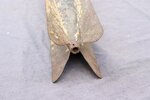 IMG-8295.jpg288.4 KB · Views: 17
IMG-8295.jpg288.4 KB · Views: 17 -
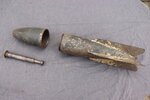 IMG-8297.jpg359.7 KB · Views: 19
IMG-8297.jpg359.7 KB · Views: 19 -
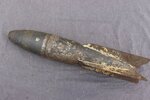 IMG-8294.jpg318.4 KB · Views: 20
IMG-8294.jpg318.4 KB · Views: 20 -
 img_230912.jpg107.4 KB · Views: 22
img_230912.jpg107.4 KB · Views: 22 -
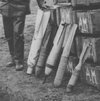 Salonique-Nov-1916-Screenshot-2021-07-06-205214.jpg51.3 KB · Views: 24
Salonique-Nov-1916-Screenshot-2021-07-06-205214.jpg51.3 KB · Views: 24 -
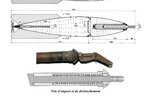 img_230887.jpg87.3 KB · Views: 22
img_230887.jpg87.3 KB · Views: 22 -
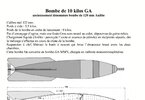 img_230886.jpg125.8 KB · Views: 22
img_230886.jpg125.8 KB · Views: 22
Big Sky Modeler
New Member
This is a very informative and detailed description of the Gros-Andreau bombs. Thank you! The accompanying pictures are great as well. I build WWI airplane models and have found it difficult to find information on French WWI bombs. This forum is an excellent resource.From what I know of the Gros-Andreau bombs, they were originally painted white with a red stripe midway across the ogive, but I've seen many differences in the colouring between the two halves of the bomb.
The way they worked was they had thin casings in two halves - the rear was filled with gaseous nitrogen dioxide (called "nitrogen peroxide" at the time) sealed by a brass disc and the front was filled with kerosene. At the very front, the bomb had a steel plunger compressing a spring and held back by a protruding "tongue" and a couple of shear pins. This tongue was also part of the suspension mechanism at the front, interfacing the launcher - it was shaped somewhat like a sickle and had a pivot at the midpoint, with the pivot fitting in a groove on the launcher and the furthest point of the tongue pinned in place. The rear of the bomb would rest on a "rack" and when you wanted to launch it, the rack is pulled back, leaving the bomb attached only at the front. The resulting torque on the tongue shears the two pins, leaving the tongue attached to the aircraft and freeing the plunger, which pierces the brass disc separating the two halves, allowing the gas and kerosene to mix...
Ignition is provided by a Gros non-delay fuze with an arming vane safety situated at the back of the bomb.
Later in the war, because of problems with nitrogen dioxide leaking (which si also very toxic, fyi) most of these bombs were refilled with melinite or MMN and thus coloured yellow, but they kept their distinctive "tongue" mechanism in order to still fit the launchers, so I wonder if the bomb in the picture is not one of these, with the ogive repainted yellow, but the back still in it's original white to save on paint?
Big Sky Modeler
New Member
I am having a hard time seeing the details of the front of the bomb rack where the tongue of the bomb fits. Are there any pictures or drawings that show this detail more clearly?From what I know of the Gros-Andreau bombs, they were originally painted white with a red stripe midway across the ogive, but I've seen many differences in the colouring between the two halves of the bomb.
The way they worked was they had thin casings in two halves - the rear was filled with gaseous nitrogen dioxide (called "nitrogen peroxide" at the time) sealed by a brass disc and the front was filled with kerosene. At the very front, the bomb had a steel plunger compressing a spring and held back by a protruding "tongue" and a couple of shear pins. This tongue was also part of the suspension mechanism at the front, interfacing the launcher - it was shaped somewhat like a sickle and had a pivot at the midpoint, with the pivot fitting in a groove on the launcher and the furthest point of the tongue pinned in place. The rear of the bomb would rest on a "rack" and when you wanted to launch it, the rack is pulled back, leaving the bomb attached only at the front. The resulting torque on the tongue shears the two pins, leaving the tongue attached to the aircraft and freeing the plunger, which pierces the brass disc separating the two halves, allowing the gas and kerosene to mix...
Ignition is provided by a Gros non-delay fuze with an arming vane safety situated at the back of the bomb.
Later in the war, because of problems with nitrogen dioxide leaking (which si also very toxic, fyi) most of these bombs were refilled with melinite or MMN and thus coloured yellow, but they kept their distinctive "tongue" mechanism in order to still fit the launchers, so I wonder if the bomb in the picture is not one of these, with the ogive repainted yellow, but the back still in it's original white to save on paint?
From "Fonds Valois" BDIC_VAL_411_021 : Villacoublay 1916
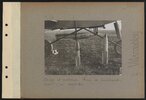
Quite frequently the GA bombs were transported inside the plane, armed by hand by the observer bomber and thrown over by him. Therefore the high number of "poisoning" incidents of crews due to gaz emanating from these bombs.
BTW the 5th wing RNAS used Gros Andrau bombs on its Caudron G4 and Strutter - a local initiative apparently as these bombs seem to have been acquired directly from the Gros factory ("Pyrotechnie du Pecq") and therefore appear in the operational reports as "Le Pecq" bombs and not as Gros Andrau.
Wingsofwrath, hi!
Your statement about the color of the GA bombs raises some questions:
The overall white paint with a dark band (red? blue?) was exceptionally seen on GA bombs - the only 2 samples I know are a post war photograph of what may be a GAMMN and this famous photograph from Thessaloniki - However this coloration was frequently seen on Michelin bombs and above was standard on on Italian (not French) bombs.

I have been unable to find written reference for the painting of these GA bombs.
Do you have a reference that can be trusted for this coloration?
From the photographs I have seen they seem to have been generally left in natural metal with various levels of corrosion or with a light shade (apparently not white) overall paint roughly applied.
The issue of dark/black portions of these bombs as well ason the earlier "obus empennes" raises two possibilities:
1) as you stated this is yellow paint appearing dark on chromatic films used in this poeriod.
2) they were in fact cast iron ("fonte" in French) and not steel ("acier") in French and this was therefore their natural unpainted coloration.
The GA/ GAMMN from 1917 seems to have been painted grey-green with a colored band (light blue, red or light green) see here:
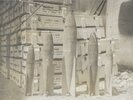
BTW The photograph from the bomb park at Saloniki is a much interesting and discussed photograph as it includes two "un-repertoried" bombs (at extreme left amnd extreme right) - though also known from other photographs/movies.
The one on the left has already been extensively discussed in other thread but yet without formal identification.
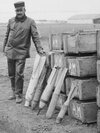

Quite frequently the GA bombs were transported inside the plane, armed by hand by the observer bomber and thrown over by him. Therefore the high number of "poisoning" incidents of crews due to gaz emanating from these bombs.
BTW the 5th wing RNAS used Gros Andrau bombs on its Caudron G4 and Strutter - a local initiative apparently as these bombs seem to have been acquired directly from the Gros factory ("Pyrotechnie du Pecq") and therefore appear in the operational reports as "Le Pecq" bombs and not as Gros Andrau.
Wingsofwrath, hi!
Your statement about the color of the GA bombs raises some questions:
The overall white paint with a dark band (red? blue?) was exceptionally seen on GA bombs - the only 2 samples I know are a post war photograph of what may be a GAMMN and this famous photograph from Thessaloniki - However this coloration was frequently seen on Michelin bombs and above was standard on on Italian (not French) bombs.

I have been unable to find written reference for the painting of these GA bombs.
Do you have a reference that can be trusted for this coloration?
From the photographs I have seen they seem to have been generally left in natural metal with various levels of corrosion or with a light shade (apparently not white) overall paint roughly applied.
The issue of dark/black portions of these bombs as well ason the earlier "obus empennes" raises two possibilities:
1) as you stated this is yellow paint appearing dark on chromatic films used in this poeriod.
2) they were in fact cast iron ("fonte" in French) and not steel ("acier") in French and this was therefore their natural unpainted coloration.
The GA/ GAMMN from 1917 seems to have been painted grey-green with a colored band (light blue, red or light green) see here:

BTW The photograph from the bomb park at Saloniki is a much interesting and discussed photograph as it includes two "un-repertoried" bombs (at extreme left amnd extreme right) - though also known from other photographs/movies.
The one on the left has already been extensively discussed in other thread but yet without formal identification.

Last edited:
wingsofwrath
Well-Known Member
Ok, I see this thread has exploded while I was stuck three weeks in hospital and unable to access BOCN (blocked by the hospital's firewall, because oh noes, talking about ordnace is dangerous to our fragile psyches, dontcha know?  )
)
So, first thing first, I retract my assertion that the GAMMN bombs were yellow, that's my mistake and it was because when I saved a bunch of French manuals off of Gallica way back when I accidentally transposed two digits and made an 1932 manual as being from 1923 and then never bothered to check the first page again... Oops.
I looked at a different 1932 manual which had drawings and it shows that the switch to yellow was a recent thing, before then the bombs being grey, as you said.

That out of the way, I think the stripes on the GA bombs appeared some time in mid-to late 1916, because every picture I've seen afterwards from various theatres show the bombs as being striped. My research was primarily interested in the use of GA bombs by the Romanian Air Force (according to documents we imported some 3000 of them) and the very few pictures where any bomb is present show stripes (not going to bother posting any, because they are general photos of airfield operations and you need a lot of squinting to even make out the bombs).
As for the assertion that the stripe is red, that's my own conjecture and it's based solely on photographic evidence, because I haven't yet found a single shred of written evidence as to the colour. There is a possibility they say so in this manual, currently for sale, but I'm in two minds wherever to spend 40 euros to find out wherever that info even is there, considering the GA bombs were a bit of a sideshow for me anyway.
The rationale is as follows, and can be exemplified very well in this nifty piece of footage of Farman 40 operations at Le Bourget in 1917, from which I'd already shared one screen capture.
First off, you can see at the very start of the clip, when the aeroplane is brought out, that this is clearly orthochromatic film stock, because you can see both the tail markings and the fuselage chevron (red and sky-blue, denoting an aircraft belonging to the "Camp retranché de Paris") where the red appears very dark and the blue almost white.
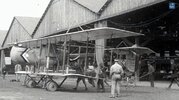
Later in the clip, when the bombs are bought out (at about 3:00), the stripe is also very dark but not fully black, thus suggesting it's red rather than blue, since even medium blue like that of the national insignia appears light enough in the film footage as to be almost invisible.

And here is the red of the National insignia under the same lighting conditions (you can barely see the center blue dot of the "cocarde"):
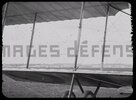
Of course, another thing is the colour variation on the bombs themselves - the front is clearly white, but the back is some darker shade, either grey or natural metal, although the lack of metal sheen would suggest paint rather than them being unpainted.
When it comes to the thickness of the casing, we know for sure that the GA bomb bodies were made out of of sheet metal rather than cast, because not only are the bombs themselves know occasionally as "bombe a paroi mince" (thin casing bomb), the plans we have show the thickness is given as 2,5mm with thicker inserts in the join line to allow the halves to screw together and even that extant example that I shared shows this type of construction.
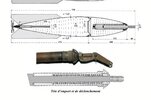

Finally, I have found an even better description of the GA fuze than the one I originally did, which neglected to mention the collar holding the vanes of the tail screw in place until the bomb is launched to prevent premature detonation in flight, and I will reproduce it here in full:
"The Gros-Andreau key is hooked on a pin through a plunger and its round end held firmly against a collar by means o f a spring action on the plunger. A small safety
pin through the key and the plunger serves to prevent its slipping out prematurely. The key is fastened to the bomb release by means of the two holes in the other end. The collar is also securely fastened to the carrier by means of the wire loop. When the release is operated it exerts a lever action on the key, which serves to shear the small safety pin and snap the key off of the plunger. The collar is then pulled off and permits the rotation o f the screw. As the propeller rotates it screws down the stem toward the nose of the bomb and finally off of the thread. It liberates the ball, which acts to hold the plunger up. When the plunger strikes the target it is driven against the primer."
This comes from pages 276-277 of the "Handbook of Ordnace Data" published by the US Ordnance Department in 1918 and available on Bulletpicker, here.
EDIT: And another thing I just realized - in your picture of serveral GA/GAMMN bombs standing up, which is obviously panchromatic film from the lack of contrast between similar hues, the middle bomb has some fainlty visible "A"s on the ogive and one on the tail with a faintly visible stripe under the top one on which the filling information is written . Now this actually fits with that extant bomb example that I shared, which has fainly visible red "A"s and a yellow stripe just below it... the only problem is this bomb has been repainted from white to dark green instead of blue-gray... What do we think of this, because I haven't a clue...
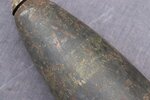
So, first thing first, I retract my assertion that the GAMMN bombs were yellow, that's my mistake and it was because when I saved a bunch of French manuals off of Gallica way back when I accidentally transposed two digits and made an 1932 manual as being from 1923 and then never bothered to check the first page again... Oops.
I looked at a different 1932 manual which had drawings and it shows that the switch to yellow was a recent thing, before then the bombs being grey, as you said.

That out of the way, I think the stripes on the GA bombs appeared some time in mid-to late 1916, because every picture I've seen afterwards from various theatres show the bombs as being striped. My research was primarily interested in the use of GA bombs by the Romanian Air Force (according to documents we imported some 3000 of them) and the very few pictures where any bomb is present show stripes (not going to bother posting any, because they are general photos of airfield operations and you need a lot of squinting to even make out the bombs).
As for the assertion that the stripe is red, that's my own conjecture and it's based solely on photographic evidence, because I haven't yet found a single shred of written evidence as to the colour. There is a possibility they say so in this manual, currently for sale, but I'm in two minds wherever to spend 40 euros to find out wherever that info even is there, considering the GA bombs were a bit of a sideshow for me anyway.
The rationale is as follows, and can be exemplified very well in this nifty piece of footage of Farman 40 operations at Le Bourget in 1917, from which I'd already shared one screen capture.
First off, you can see at the very start of the clip, when the aeroplane is brought out, that this is clearly orthochromatic film stock, because you can see both the tail markings and the fuselage chevron (red and sky-blue, denoting an aircraft belonging to the "Camp retranché de Paris") where the red appears very dark and the blue almost white.

Later in the clip, when the bombs are bought out (at about 3:00), the stripe is also very dark but not fully black, thus suggesting it's red rather than blue, since even medium blue like that of the national insignia appears light enough in the film footage as to be almost invisible.

And here is the red of the National insignia under the same lighting conditions (you can barely see the center blue dot of the "cocarde"):

Of course, another thing is the colour variation on the bombs themselves - the front is clearly white, but the back is some darker shade, either grey or natural metal, although the lack of metal sheen would suggest paint rather than them being unpainted.
When it comes to the thickness of the casing, we know for sure that the GA bomb bodies were made out of of sheet metal rather than cast, because not only are the bombs themselves know occasionally as "bombe a paroi mince" (thin casing bomb), the plans we have show the thickness is given as 2,5mm with thicker inserts in the join line to allow the halves to screw together and even that extant example that I shared shows this type of construction.


Finally, I have found an even better description of the GA fuze than the one I originally did, which neglected to mention the collar holding the vanes of the tail screw in place until the bomb is launched to prevent premature detonation in flight, and I will reproduce it here in full:
"The Gros-Andreau key is hooked on a pin through a plunger and its round end held firmly against a collar by means o f a spring action on the plunger. A small safety
pin through the key and the plunger serves to prevent its slipping out prematurely. The key is fastened to the bomb release by means of the two holes in the other end. The collar is also securely fastened to the carrier by means of the wire loop. When the release is operated it exerts a lever action on the key, which serves to shear the small safety pin and snap the key off of the plunger. The collar is then pulled off and permits the rotation o f the screw. As the propeller rotates it screws down the stem toward the nose of the bomb and finally off of the thread. It liberates the ball, which acts to hold the plunger up. When the plunger strikes the target it is driven against the primer."
This comes from pages 276-277 of the "Handbook of Ordnace Data" published by the US Ordnance Department in 1918 and available on Bulletpicker, here.
EDIT: And another thing I just realized - in your picture of serveral GA/GAMMN bombs standing up, which is obviously panchromatic film from the lack of contrast between similar hues, the middle bomb has some fainlty visible "A"s on the ogive and one on the tail with a faintly visible stripe under the top one on which the filling information is written . Now this actually fits with that extant bomb example that I shared, which has fainly visible red "A"s and a yellow stripe just below it... the only problem is this bomb has been repainted from white to dark green instead of blue-gray... What do we think of this, because I haven't a clue...

Last edited:

